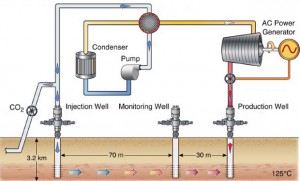Carbon is not only the most common element and the basis for all matter that we know, it’s also the root of harmful pollution and environmental woes. In the spirit of ‘fighting fire with fire’, an aspiring research team from Lawrence Berkley National Laboratory has mapped out a method by which to turn CO2 from a would-be pollutant into an electricity generating catalyst.
Geothermal electricity production typically uses water as the vehicle, whereby the Earth’s heat converts the water to steam which then spins the turbines to create power. In the case of the Berkley Lab project, carbon dioxide is fed into the ground instead, where the geothermal heat puts it into a super-critical state (it has properties of both liquid and gas). After that, the CO2 is drawn back up to the surface, where turbines convert it to electricity.
The project is set to begin testing in Cranfield, Mississippi soon, at which point researchers hope to finally convert decade-old theories into proof. Whether the new technology is viable as a mainstream method of electricity generation is still up for grabs, but if successful, the breakthrough process could have more benefits than just power production.
Firstly, this type of process could bring geothermal energy to drier locales, where water is scarce. It could become a far more flexible and viable green energy standard in places previously thought incompatible for such methods. Using super-critical CO2 has long been proposed as a possible alternative to water in geothermal electricity generation, but never tested.
Also, much of our pollution (stemming mostly from commercial and industrial waste and byproducts) is abated using techniques that serve to bury CO2 deep underground and away from our atmosphere, but it’s very costly and requires a great amount of effort and hardware. However, using the new geothermal generation process, all that excess CO2 would instead be put to good use in electricity production.
“We actually want some of the CO2 to become trapped,? says BarryFreifeld, the project leader for Berkley Lab. ?Our approach relies on this gradual loss as a way to store a power plant?s CO2 underground rather than emitting it into the atmosphere. Our planned demonstration is the first attempt at proving that we can simultaneously mitigate greenhouse gas induced climate change and generate clean baseload power using geothermal energy.?
Furthermore, the ‘fuel’ is recycled through the system and reused, and the power it generates could help offset the cost of burying and storing CO2.



